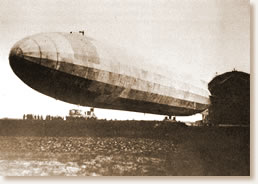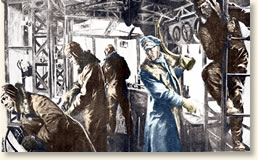|
Death of a Zeppelin, 1916
The German Zeppelins were the ultimate terror weapon of their day. Silent behemoths, they prowled the night skies seemingly impervious to attack by plane or antiaircraft fire. Just the mention of the name "Zeppelin" was enough to send cold chills up and down the spines of their intended victims.
The dirigible's name came from one of its German designers - Ferdinand von Zeppelin
- who introduced his first giant airship at the turn of the 20th century. With
the outbreak of war, they were quickly pressed into service as bombers and
reconnaissance
aircraft. The first bombing raid on London was made during the night of May
31, 1915 by a single ship. Other raids followed, with as many as 16 Zeppelins
attacking in a single night.
 |
The first Zeppelin to raid London
The LZ 38
At its home base, 1915 |
Initially, defenders were powerless as the Zeppelins flew at altitudes too high for defending aircraft or artillery to reach. Mother Nature was the Zeppelin's primary enemy as the unwieldy craft were easily thrown off course by high winds. Additionally, the darkness of their night raids made it difficult for crews to find their targets.
Although the actual material damage inflicted by the Zeppelins was minimal, their psychological impact on the British population was significant. Precious air and ground units were diverted from the war front to the home front to counter this threat from the sky.
As the war progressed, technological advances that allowed defending aircraft to reach or exceed the Zeppelin's altitude and the introduction of incendiary bullets, turned the advantage to the defenders. By the end of the war, the Zeppelin had been withdrawn from combat.
Michael MacDonagh was a reporter for a London newspaper. He witnessed the destruction
of one of the giant airships as it took part in a raid on the city during
the night of October 1, 1916:
"I saw last night what is probably the most appalling spectacle associated with the war which London is likely to provide - the bringing down in flames of a raiding Zeppelin.
I was late at the office, and leaving it just before midnight was crossing to Blackfriars Bridge to get a tramcar home, when my attention was attracted by frenzied cries of 'Oh! Oh! She's hit!' from some wayfarers who were standing in the middle of the road gazing at the sky in a northern direction. Looking up the clear run of New Bridge Street and Farringdon Road I saw high in the sky a concentrated blaze of searchlights, and in its centre a ruddy glow which rapidly spread into the outline of a blazing airship. Then the searchlights were turned off and the Zeppelin drifted perpendicularly in the darkened sky, a gigantic pyramid of flames, red and orange, like a ruined star falling slowly to earth. Its glare lit up the streets and gave a ruddy tint even to the waters of the Thames.
The spectacle lasted two or three minutes. It was so horribly fascinating that I felt spellbound - almost suffocated with emotion, ready hysterically to laugh or cry. When at last the doomed airship vanished from sight there arose a shout the like of which I never heard in London before - a hoarse shout of mingled execration, triumph and joy; a swelling shout that appeared to be rising from all parts of the metropolis, ever increasing in force and intensity. It was London's Te Deum for another crowning deliverance. Four Zeppelins destroyed in a month!...
I got from a member of the Potter's Bar anti-aircraft battery an account of the bringing down of the Zeppelin. He said the airship was caught in the beams of three searchlights from stations miles apart, and was being fired at by three batteries also from distances widely separated. She turned and twisted, rose and fell, in vain attempts to escape to the shelter of the outer darkness. None of the shells reached her. Then an aeroplane appeared and dropped three flares - the signal to the ground batteries to cease firing as he was about to attack. The airman, flying about the Zeppelin, let go rounds of machine-gun fire at her without effect, until one round fired into her from beneath set her on fire, and down she came a blazing mass, roaring like a furnace, breaking as she fell into two parts which were held together by internal cables until they reached the ground.
The framework of the Zeppelin lay in the field in two enormous heaps, separated from each other by about a hundred yards. Most of the forepart hung suspended from a tree. . .
The crew numbered nineteen. One body was found in the field some distance from the wreckage. He must have jumped from the doomed
 |
Zeppelin crew
From a contemporary illustration, 1915 |
airship from a considerable height. So great was the force with which he struck the ground that I saw the imprint of his body clearly defined in the stubbly grass. There was a round hole for the head, then deep impressions of the trunk, with outstretched arms, and finally the widely separated legs. Life was in him when he was picked up, but the spark soon went out. He was, in fact, the Commander, who had been in one of the gondolas hanging from the airship. . .
With another journalist I went to the barn where the bodies lay. As we approached we heard a woman say to the sergeant of the party of soldiers in charge, 'May I go in? I would like to see a dead German.' 'No, madam, we cannot admit ladies,' was the reply.
Introducing myself as a newspaper reporter, I made the same request. The sergeant said to me, 'If you particularly wish to go in you may. I would, however, advise you not to do so. If you do you will regret your curiosity.' I persisted in my request. . .
Explaining to the sergeant that I particularly wanted to see the body of the Commander, I was allowed to go in. The sergeant removed the covering from one of the bodies which lay apart from the others. The only disfigurement was a slight distortion of the face. It was that of a young man, clean-shaven. He was heavily clad in a dark uniform and overcoat, with a thick muffler round his neck.
I knew who he was. At the office we had had official information of the identity of the Commander and the airship (though publication of both particulars was prohibited), and it was this knowledge that had determined me to see the body. The dead man was Heinrich Mathy, the most renowned of the German airship commanders, and the perished airship was his redoubtable L31.
Yes, there he lay in death at my feet, the bugaboo of the Zeppelin raids, the first and most ruthless of these Pirates of the Air bent on our destruction."
References:
Michael MacDonagh's account appears in: MacDonagh, Michael, In London during the Great War; the diary of a journalist (1935); Robinson, Douglas, Giants in the Sky, a history of the rigid airship (1973).
How To Cite This Article:
"Death of a Zeppelin, 1916," EyeWitness to History, www.eyewitnesstohistory.com (2005).
|






